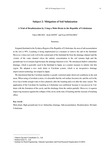A Trial of Desalinization by Using a Mole-Drain in the Republic of Uzbekistan
JIRCAS Working Report
| ISSN | 1341710X |
|---|---|
| NII recode ID (NCID) | AA11159468 |

Full text
jircas_working_report88-_65-74.pdf624.85 KB
Irrigated farmland in the Syrdarya Region of the Republic of Uzbekistan, the area of salt accumulation in the soil is 98%. Leaching is being implemented as a measure to remove the salt in the farmland. However, it does not work well in the central part of the farmland far from the drainage channel and the vicinity of the water channel where the salinity concentration in the soil remains high and the groundwater level remains high because the drainage function is low. We introduced shallow subsurface drainage, which is generally used in the farmland in Japan, as a counter measure to salinity into this region. We adopted a new mole drain or Cut-drain system, which is an inexpensive drainage improvement technology developed in Japan.
We determined that the Cut-drain machine is greatly restricted under dried soil conditions in the arid areas. When using a Cut-drain system, it is desirable that the soil surface becomes dry and the soil in the lower layer holds enough water to have plasticity after the leaching and even after the rainy season. The application of the Cut-drain for leaching in Uzbekistan was confirmed, because it was proven by Cutdrain with the formation of the cavity and the discharge from the outlets partially. However, it requires improving measures against the collapse of the cavity at the time of leaching and the increase of leaching effect.
We determined that the Cut-drain machine is greatly restricted under dried soil conditions in the arid areas. When using a Cut-drain system, it is desirable that the soil surface becomes dry and the soil in the lower layer holds enough water to have plasticity after the leaching and even after the rainy season. The application of the Cut-drain for leaching in Uzbekistan was confirmed, because it was proven by Cutdrain with the formation of the cavity and the discharge from the outlets partially. However, it requires improving measures against the collapse of the cavity at the time of leaching and the increase of leaching effect.
| Date of issued | |
|---|---|
| Creator | Yukio OKUDA Koki GOTO Iwao KITAGAWA |
| Subject | Mole-drain High groundwater level Subsurface drainage Salt-accumulation Desalinization Dryland Uzbekistan |
| Volume | 88 |
| spage | 65 |
| epage | 74 |
| Relation | isPartOf : JIRCAS Working Report no.88 |
| Language | eng |
Related Publication
isPartOf
